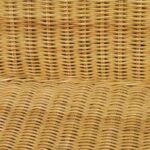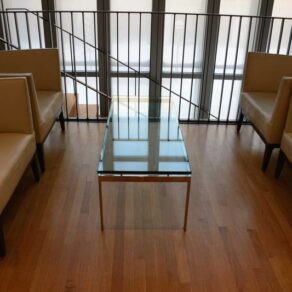Kim asked: How do I clean, strengthen and revive rattan furniture? I used to have directions using boiled linseed oil that worked great, but I must have lost them. Has anyone ever heard of this method?
Rattan  is an attractive, lightweight, and durable material for furniture. It’s also eco-friendly, as the plants are fast-growing and plentiful. Whether you choose to display your rattan indoors or out, following these steps will keep your rattan clean and in good repair.
is an attractive, lightweight, and durable material for furniture. It’s also eco-friendly, as the plants are fast-growing and plentiful. Whether you choose to display your rattan indoors or out, following these steps will keep your rattan clean and in good repair.
You Will Need:
- Dishwashing detergent
- Water
- Soft cloth(s)
- Bowl
- Toothbrush
- Boiled linseed oil
- Lacquer
- Paintbrush
Steps to Clean the Rattan:
- Fill a bowl with water. Add a few drops of dish detergent and stir to agitate until bubbles form on the surface.
- Dip a soft cloth into the bubbles only, not into the water.
- Wipe the rattan with the bubbles. The slight moisture cleans without over-wetting the rattan, which can cause damage.
- Use a toothbrush or other soft brush to clean in the cracks and crevices, using the same suds-only cleaning method.
- Repeat weekly for best results.
- To restore dry, cracked, or split rattan, apply boiled linseed oil with a brush. When the furniture won’t absorb any more oil, wipe it clean with a soft cloth. Allow it to dry or harden before using the rattan again.
- For a thorough cleaning or to remove stains, apply detergent and scrub with slightly more water than you do for routine cleaning. As soon as you’re done, dry the rattan with a hot hair dryer or set it out in the sun. Once the rattan has dried completely, apply a coat of lacquer with a paintbrush to provide added protection if desired. Repeat annually.
Additional Tips and Advice
- Although rattan may be used outdoors, it’s best not to leave it in the sun or otherwise exposed to the elements. The material will break down much more quickly under these circumstances.
- Place rubber stoppers under the legs of rattan. The cushion helps keep the material from cracking or splitting.
- Make sure you use BOILED linseed oil. Raw linseed oil will not dry or harden. Boiled linseed oil is available at most hardware stores. (You do not actually boil it yourself.)









Hi, and thanks for the information on cleaning my Rattan garden furniture. It has been a massive help. I bought my Rattan furniture new from the store, and although its still great, it could do with a good cleaning now! Thanks once again for your help. H X
The decorator sold us rattan furniture to use on our lanai in Florida. The furniture looks terrible due to mildew and peeling. I may have to just junk it and buy the typical plastic furniture! Over the years we have cleaned it and applied lacquer, but it only lasts for about a year before looking terrible again. What an expensive mistake!
I have full rattan furniture from Braxton Culler that is 18 years old and for the last five years has been on my lanai in Florida. I keep it mostly out of direct sun, but it does get rained on a bit. Each year I apply Maximum Olympic Stain that has acrylic in it and it looks better than new.
I only need to touch it up in areas and it’s done in minutes. All my neighbors comment on how great it always looks. The stain does chip in areas, so I sand that area a little and brush on more stain; it looks great.
Eventually areas that did chip off don’t come back.
I have two chairs, two couches, one end table, one coffee table, and a ottoman that requires about two hours per year maintenance.
If you are using rattan, wood or anything subject to weathering in the strong sun, you should use at least three coats thinly applied UV coating. There are many on the market; go to a hardware store where they know what they are talking about (hint: they will ask you a few questions about your project before they will give you an answer.)
Thank you for the boiled linseed oil tip. I have two 150+ year old ratan chairs that my great-grandfather made. It sounds like this will help them in our dry NM climate.
Thanks for the instructions in how to clean rattan furniture. I have six dining room chairs that are rattan and dirty. I am wondering if the boiled linseed oil will change the color?
William,
The short answer is that yes, the linseed oil will change the color of the rattan. As rattan ages, the color often fades, and the linseed oil will soak into the rattan, restoring its natural color, so in this way the oil is not actually dying or staining it, just restoring it. However, linseed oil is a yellow-tinted liquid, so if it is applied to very light colors of rattan, it may darken the rattan or give it a yellowish tint.
Source: The Room Journal – Thanks, Mom + How To Restore Rattan Furniture
Source: YouTube – Oil Finish Comparison
Thank you for the information on boiled linseed oil. I use cushions on my rattan chair. Will the linseed oil stain them?
Diane,
Boiled linseed oil is not like other oils in that it dries, which allows it to act like a hard finish. The oil soaks into the rattan, then the excess should be wiped off. Let it dry over the next few days, then you can safely put the cushions on the chair. To be sure, you can wrap one of the cushions in an old towel to test it out for a day.
Source: The craftsman Blog – How To: Use Boiled Linseed Oil (Safely)
Is it okay to paint my rattan wicker chairs (white) after it is treated with boiled linseed oil?
Elizabeth,
You should not paint wicker after it has been treated with oil as the oil will prevent the paint from gripping the surface. Instead, first clean off the linseed oil by scrubbing the piece thoroughly and using a mild soap, then if needed, you can wipe the wicker with a sanding fluid to further remove any surface oil. Afterward, the wicker can be painted.
Source: The New York Times – Home Improvement
This information is very helpful regarding the boiled linseed oil. I just got an old set from a yard sale and I’m working on fixing it up. My question is that there is leather wrapping mixed throughout the rattan webbing. Will the linseed oil be good for the leather also?
Linda,
Yes, the linseed oil will act as a conditioner for the leather.
Source: HowToCleanStuf.net – How to Clean Leather Upholstery
Please can you help me? My garden furniture has cement stains because of some workers. How can I clean it off?? Any ideas?
Kylie,
If the stains are thick globs of cement, it might just be best to use a little sandpaper to carefully remove them; only sand the cement, not the rattan. If the stains are thin and flat, then you can try using some white vinegar to remove them. If the cement does not come off right away, wet a paper towel with the vinegar, press it against the stain, and let it sit for a few minutes to soften the cement so it can be removed. After the stains are removed, clean the rattan as usual to remove any residue from the vinegar. Good luck!
Source: HowToCleanStuff.net – How to Remove Cement from Tile
I have rattan bed frame that was painted white. How can I remove the paint to show its natural color?
Terry,
Removing that much paint will require a paint stripper. If you want to use a commercial product, be sure to get one that is safe for wood, such as Klean-Strip. Mineral spirits is also a good choice as that is commonly used to clean rattan. Wipe on the stripper, let it sit for a few minutes, then if you can do this in the yard, spray the bed frame with a garden hose to help remove the paint. Apply more mineral spirits or paint thinner as needed and scrub the rattan with a soft-bristled scrub brush until all of the paint is gone (you can intermittently spray it with the hose as well if that is more effective at removing the paint). When the paint is removed, thoroughly clean the bed frame to remove any residue from the mineral spirits, then condition the rattan to keep it supple. Good luck!
Source: DIY Newtowrk – How to Remove Paint from Metal and Wicker
Source: Hunker – How to Remove Paint from Wicker
Source: The Washington Post – QSome time ago, you wrote a…
I purchased a rattan wicker planter. It is presently a little bit too white. Do I need to dye it or will it yellow with time and a bit of sun? It is kept inside in an occasionally sunny corner.
Diane,
Rattan is naturally a beige color, so if your item is white, that likely means it’s painted. Some white paints yellow over time, especially in sunlight, but each brand/kind reacts diffferently so there is no way to tell exactly if or when it might yellow. To speed the process, try leaving it out in direct sunlight for a few days; that may help speed the yellowing. Good luck!
I just bought a rattan chair set from a thrift store. It is quite old and made of thick (1 and a half inch?) bamboo type wood. The back and arms are darkened and a bit sticky. I started to clean it using the bubbles and minimal water trick. It seems to be taking off a lot of the color… any advice???
Mary,
It is most likely the old oil on the rattan that is causing the stickiness and darkening. The color removal that you see is the old oil being removed and the color should be restored when you apply the new boiled linseed oil. Good luck!
I have white-wash paint on my wicker chairs and glass top table. They are dirty and some of the paint has rubbed off. The arms are 5 inches wide, so it’s not the old-fashioned rattan.
How do I renew them? I hope you have some good advice.
Joan,
First clean the wicker to remove the dirt. Then, since the paint has been removed, it will need to be repainted. You can either touch up the areas where the paint is missing or repaint the entire chair. Good luck!
I have a rattan suitcase which is 70 years old and is need of serious TLC. Can you advise how to clean it?
Carol,
A rattan suitcase can be cleaned using the same methods here for furniture. Work in small sections at a time so you can be careful not to let the suds drip down into any cracks, which they shouldn’t anyway as you aren’t using much moisture, but that would be important on a suitcase since there is glue and other materials underneath that should not get wet.. Also use caution when applying the oil that it doesn’t drip into any cracks. To clean the inside of the suitcase, see the guide How to Clean Vintage Luggage. Good luck!
Could you help? I had to put essential oils around the bathtub and sink to discourage ants, and it’s left ugly stains on both. How can I clean this?
Hi Emily,
The stains from essential oils can be treated the same way as other oil stains (cooking oil, motor oil, etc.): using a poultice. Mix an absorbent powder like baking soda with a cleaning solution that works well for breaking up oil such as pure acetone, mineral spirits or even isopropyl alcohol may work. Once you have made a thick paste with the ingreidnets, spread it over the stains in a thick mound and let it dry. Once dry, brush it off and hopefully the stains will be gone. If not, you can repeat the process as many times as needed, or try using break cleaner as described in the guide How to Remove Oil Stains from Tile and Grout. Good luck!